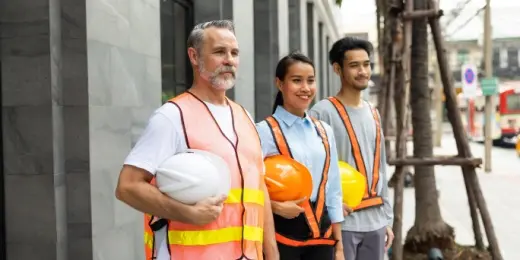What are Summer Safety Tips?
Summer safety tips are guides for enjoying, working, and living during the summer without compromising one’s health and safety. There are general summer safety tips that everyone should follow, and there are also specific ones for kids and for those who work under the sun regularly.
Most Common Summer Illnesses
Summer is a time when the temperature rises exponentially, exposing people to different heat-related risks and illnesses. As the years go by, summer continues to grow hotter as well. This goes for people of all ages, regardless of their location.
Some common illnesses during the summer season are:
- Asthma attacks
- Chickenpox
- Conjunctivitis
- Flu
- Hyperthermia
- Heat rashes, blisters, and redness
Some of the symptoms of heat exhaustion and heat illness include:
- High body temperature
- Headache
- Dizziness
- Changes in skin condition (dry, damp, pale, clammy, blistered)
- Vomiting
- Heavy sweating
- Fainting
General Summer Safety Tips

A construction worker in the summer.
Regardless of work, age, and location, there are general summer safety tips doctors promote to prevent or lessen the chances of heat illnesses and heat stress. Some of the most recommended tips are the following:
- Use broad-spectrum sunscreens to avoid sunburns, rashes, blisters, and redness
- Drink water or drinks with electrolytes regularly to avoid dehydration and heat strokes
- Wear light-colored and lightweight clothing to spot ticks and other insects on the skin and avoid trapping heat
- Avoid letting food sit out under the sun for long periods without cover to ensure no insects can come in contact with it
For kids and teens
In many places around the world, summer is a time for kids and teens to play in the sun, either on the beach or elsewhere. While they are expected to follow the same safety tips adults do, there are some summer safety tips for kids specifically for guardians to know, such as:
- Apply only small amounts of sunscreen on children less than six months old
- Avoid bringing out kids under one year old to direct sunlight
- Cover children’s heads under direct sunlight
- Supervise children playing in bodies of water, regardless of whether they have a floating device or not
- Ensure child seats are not too hot to the touch before seating a child
- Discourage children from playing in playgrounds when the sun is at its highest
For workers
Certain workplace hazards only manifest in the summer due to the hot weather. This is especially true for those who work under direct sunlight and in such conditions for a prolonged period of time leading to heat stress or heat stroke. Some fields that are most at risk for this are construction, mining, and engineering.
However, working for long periods during the summer or in extreme heat conditions is discouraged by the US Centers for Disease Control and Prevention (CDC)’s National Institute for Occupational Safety and Health (NIOSH). As a summer safety tip, the CDC calls for employers to lessen or limit their employees’ time in hot places. Instead, it encourages them to work more in cooler environments or air-conditioned areas, or take more breaks. All workplaces should also have the proper ventilation system and potable water sources to help mitigate heat stress, heat cramps, heat exhaustion, fatigue, and dehydration.
Workers should also continuously wear sunscreen and other protective gear, even if some of them do not work in direct sunlight. Ultraviolet (UV) rays are found to be more intense during the summer; since sunlight and UV rays can still penetrate through windows or come from blue-light devices, wearing sunscreen indoors is essential.
SafetyCulture for a Safer Summer
Using a digital checklist can be helpful in keeping track of summer safety tips for both children and adults, especially on the go. For this, consider using SafetyCulture (formerly iAuditor).
SafetyCulture is a digital checklist app you can look into not only for complying with summer safety tips but also for ensuring compliance with general health and safety protocols. With SafetyCulture, you can store all your checklists in a cloud that you and others you authorize can access at any time. SafetyCulture also offers free editable templates in the Public Library that you can customize to fit your needs as you see fit.
Other things you can do with SafetyCulture are:
- Ensure you’re well-packed and prepared for a trip out
- Note temperature levels when outside for leisure or work
- Connect heat sensors to your checklists to better monitor temperature changes
- Report problems in the workplace with regards to heat-related concerns by raising Issues, assigning Actions to people who can address them quickly, and providing a Heads Up to your organization about them
- Analyze work performance during summer and notify points for improvement and better health and safety with the help of analytical reports



